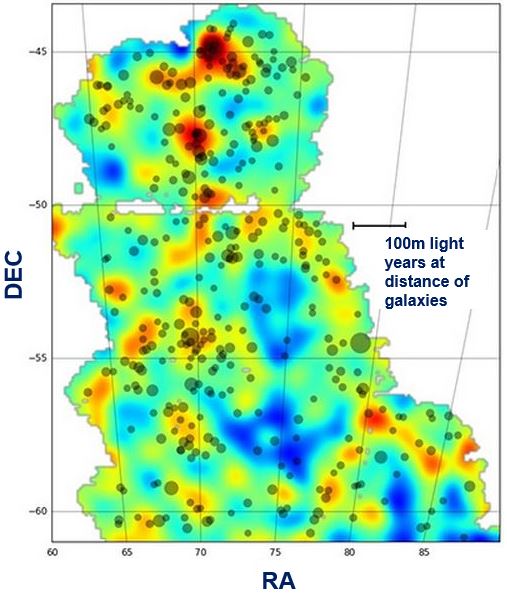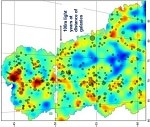Scientists have released the first in a series of dark matter maps of the Universe that should help us understand their role in the formation of galaxies. The maps were created with one of the most powerful digital cameras on Earth.
Dark matter refers to material in the universe we know is there but cannot detect by its emitted radiation. We know it is there because of its gravitational effects on visible matter, like galaxies and stars. Scientists say that one quarter the universe consists of dark matter.
Dark matter’s effects can be seen by studying gravitational lensing – the distortion that happens when the gravitational pull of dark matter bends light around distant galaxies.
 The first Dark Energy Survey map to trace the detailed distribution of dark matter across a large area of sky. Red and yellow represent regions with more dense matter. (Image: Fermilab)
The first Dark Energy Survey map to trace the detailed distribution of dark matter across a large area of sky. Red and yellow represent regions with more dense matter. (Image: Fermilab)
Maps will help understand dark energy
Scientists on the Dark Energy Survey, who released the dark matter maps, said an analysis of the clumpiness of dark matter in their maps will also help them probe the nature of the mysterious dark energy, believed to be behind the accelerating expansion of the universe.
The new maps were released on Monday at the meeting of the American Physical Society in Baltimore, Maryland. They were created using data gathered by the Dark Energy Camera, a 570-megapixel imaging device – the main instrument for the DES (Dark Energy Survey).
The scientists aim to understand the role of dark matter in order to quantify the role of dark energy, which is the survey’s ultimate goal.
Difference between dark matter and dark energy
Dark matter attracts while dark energy repels. While dark matter pulls matter inward, dark energy pushes it outward. Also, while dark energy shows itself only on the largest cosmic scale, dark matter exerts its influence on individual galaxies as well as the universe at large.
Study leader, Vinu Vikram, of Argonne National Laboratory (then at the University of Pennsylvania) and Chihway Chang of ETH Zurich. Vikram, Chang and their collaborators at Penn, the University of Manchester, the University of Portsmouth, ETH Zurich, and other DES institutions worked for over a year to carefully validate the lensing maps.
Vikram said:
“We measured the barely perceptible distortions in the shapes of about 2 million galaxies to construct these new maps.”
“They are a testament not only to the sensitivity of the Dark Energy Camera, but also to the rigorous work by our lensing team to understand its sensitivity so well that we can get exacting results from it.”
The camera was built and trialed at the Fermi National Accelerator Laboratory and is currently mounted on the 4-meter M. Blanco telescope at the National Optical Astronomy Observatory’s Cerro Tololo Inter-American Observatory in Chile. The data were processed at the National Center for Supercomputing Applications at the University of Illinois in Urbana-Champaign.
The dark matter map released yesterday made use of early DES observations and only covers approximately 3% of the area of sky that DES will document over its 5-year mission.
Comparing dark vs. visible matter
The survey has just completed two years. As researchers expand their search, they hope to better test current cosmological theories by comparing the amounts of dark versus visible matter.
According to the theories, as there is significantly more dark matter in the universe than visible matter, galaxies will form where large concentrations of dark matter, and therefore stronger gravity, are present.
The DES analysis so far backs this up. According to the maps, there are large filaments of matter along which visible galaxies and galaxy clusters lie, and cosmic voids where few galaxies are located.
Scientists will learn more about this interplay of mass and light in follow-up studies of some of the enormous filaments and voids.
Chang said:
“Our analysis so far is in line with what the current picture of the universe predicts. Zooming into the maps, we have measured how dark matter envelops galaxies of different types and how together they evolve over cosmic time. We are eager to use the new data coming in to make much stricter tests of theoretical models.”
The Dark Energy Survey is a collaboration involving over 300 scientists from 25 institutions in six nations.

